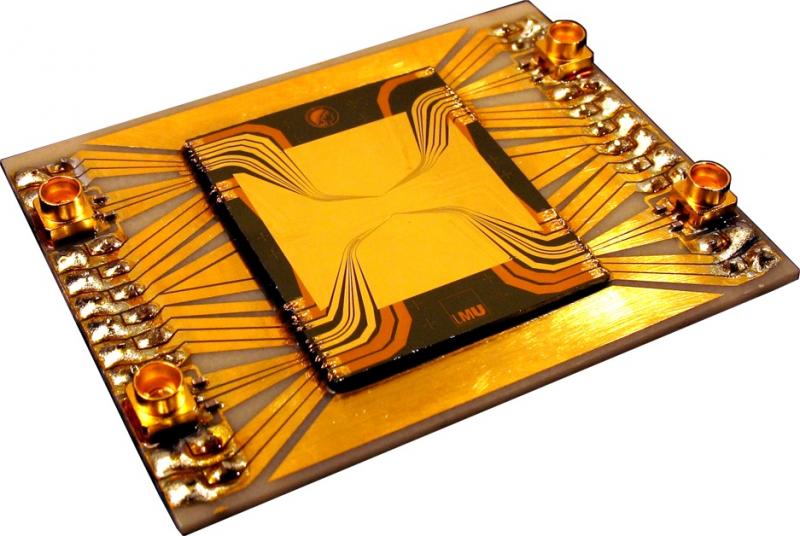Highlight
Continuous Matrix Product States for Quantum Fields
Fri, 2010-05-14 12:23 - Lukas TheusslPhys. Rev. Lett. 104, 190405 (2010)
Matrix product states (MPS) represent a powerful ansatz for the computation of ground state properties of local Hamiltonians. In this work, the authors define MPS in the continuum limit, without any reference to an underlying lattice parameter. This allows extending the density matrix renormalization group and variational matrix product state formalism to quantum field theories and continuum models in 1 spatial dimension.
Classical simulation of commuting quantum computations implies collapse of the polynomial hierarchy
Sun, 2010-05-09 14:14 - Lukas TheusslWe consider quantum computations comprising only commuting gates, known as IQP computations, and provide compelling evidence that the task of sampling their output probability distributions is unlikely to be achievable by any efficient classical means. More specifically we introduce the class post-IQP of languages decided with bounded error by uniform families of IQP circuits with post-selection, and prove first that post-IQP equals the classical class PP.
QUIE2T Virtual Institutes
Fri, 2010-05-07 15:35 - Lukas TheusslAs one of its central aims, QUIE2T WP2 has established the set of four Virtual Institutes.
The four Virtual Institutes have their homepages under http://qurope.eu/vi, and will have the content of their sites updated in the course of the project. The instute directors and secretaries are:
Wilson Fermions and Axion Electrodynamics in Optical Lattices
Mon, 2010-05-03 11:46 - Matteo RizziA. Bermudez, L. Mazza, M. Rizzi, N. Goldman, M. Lewenstein, M.A. Martin-Delgado
Phys. Rev. Lett. 105, 190404 (2010) http://link.aps.org/doi/10.1103/PhysRevLett.105.190404
The formulation of massless relativistic fermions in lattice gauge theories is hampered by the fundamental problem of species doubling, namely, the rise of spurious fermions modifying the underlying physics. A suitable tailoring of the fermion masses prevents such abundance of species, and leads to the so-called Wilson fermions. Here we show that ultracold atoms provide us with the first controllable realization of these paradigmatic fermions, thus generating a quantum simulator of fermionic lattice gauge theories. We describe a novel scheme that exploits laser-assisted tunneling in a cubic optical superlattice to design the Wilson fermion masses. The high versatility of this proposal allows us to explore a variety of interesting phases in three-dimensional topological insulators, and to test the remarkable predictions of axion electrodynamics.
QIPC Roadmap updated
Thu, 2010-04-29 15:42 - Daniele BinosiThe QIPC Strategic Report has been updated to version 1.7.
It can be consulted on the Roadmap page.
Preparation and Measurement of Three-Qubit Entanglement in a Superconducting Circuit
Sun, 2010-04-25 14:20 - Lukas TheusslTraditionally, quantum entanglement has played a central role in foundational discussions of quantum mechanics. The measurement of correlations between entangled particles can exhibit results at odds with classical behavior. These discrepancies increase exponentially with the number of entangled particles. When entanglement is extended from just two quantum bits (qubits) to three, the incompatibilities between classical and quantum correlation properties can change from a violation of inequalities involving statistical averages to sign differences in deterministic observations.
Generation of Three-Qubit Entangled States using Superconducting Phase Qubits
Sat, 2010-04-24 14:25 - Lukas TheusslEntanglement is one of the key resources required for quantum computation, so experimentally creating and measuring entangled states is of crucial importance in the various physical implementations of a quantum computer. In superconducting qubits, two-qubit entangled states have been demonstrated and used to show violations of Bell's Inequality and to implement simple quantum algorithms.
Atomic clocks use quantum timekeeping
Wed, 2010-03-31 23:12 - Daniele Binosi| The microcosm, the realm of quantum physics, is ruled by probability and chance. The behaviour of quantum particles cannot be predicted with certainty but only with certain probabilities given by quantum physics. This results in a so-called quantum noise, which fundamentally limits the precision of the most refined atomic clocks and interferometers. The solution to this problem is the use of entangled atomic systems. A break-through has now been achieved by a team around Professor Theodor W. Hänsch and Professor Philipp Treutlein (Ludwig-Maximilians-Universität Munich and Max Planck Institute of Quantum Optics in Garching, Philipp Treutlein is Professor at the Universität Basel since February 2010). For the first time the scientists succeeded in generating multi-particle entanglement on an atom-chip (Nature, Advance Online Publication, DOI: 10.1038/nature08988). This technique opens a way to significantly enhance the precision of chip-based atomic clocks or interferometers and could also form the basis for quantum computers on microchips. The Munich experiments have been carried out in cooperation with theoretical physicists around Dr. Alice Sinatra (ENS, Paris). |
Atom chip with integrated microwave guiding structures used in the Munich experiment. The chip is used for the production of Bose-Einstein condensates, for the operation of chip-based atomic clocks and atom interferometers, and for the generation of spin-squeezed and entangled states of the BEC. Picture: Philipp Treutlein, LMU Munich.
|
Cavity optomechanics using an optically levitated nanosphere
Sat, 2010-03-27 12:18 - Lukas TheusslProc. Natl. Acad. Sci. USA 107, 1005 (2010)
The authors propose a novel approach to prepare mesoscopic mechanical systems in superposition, or entangled states at room temperatures. A promising setup for the implementation of these ideas consists of levitated nanospheres coupled to high-finesse cavities.
Toward Quantum Superposition of Living Organisms
Thu, 2010-03-11 12:14 - Lukas TheusslNew J. Phys. 12, 033015 (2010)
The authors propose a novel approach to prepare mesoscopic mechanical systems in superposition, or entangled states at room temperatures. A promising setup for the implementation of these ideas consists of levitated nanospheres coupled to high-finesse cavities.


